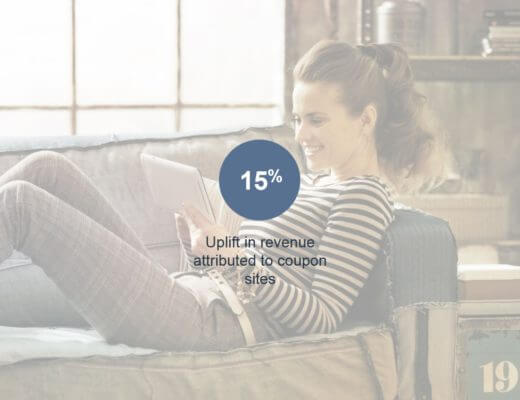3 coupon affiliate myths it’s time to stop blindly believing
Columnist James Collins shares data from Rakuten Marketing to help debunk a few of the more pervasive misconceptions about coupon affiliates.

Nevertheless, shoppers now expect coupons and deals to be readily available for their online shopping. In fact, according to research published by Deloitte (PDF), one in three transactions will involve a coupon or promotion this holiday season.
Should the myths associated with coupons stop brands from using them, potentially prompting them to miss out on business from the many customers who do use coupons? The answer is to let the data make the decisions.
Across the Rakuten Marketing network, we work with a huge number of advertisers and affiliate publishers. Thanks to this network and our proprietary attribution technology, Cadence, we have access to data that provides clarity around the common misconceptions associated with coupons.
Below, I take a look at three myths that surround coupon affiliates and provide some of the reasons why they shouldn’t be taken at face value.
Myth: Coupon affiliates only drive value at the last click
Insight into how coupon affiliates contribute at the earlier stages of the user journey gives marketers the opportunity to better understand their investment. While coupons do provide value as the final touch point, it’s important to understand that they can also have an impact throughout the user journey.
Analysis of data for a high-end fashion retailer client revealed that coupon affiliates most commonly appear in the middle of the journey, during the research phase (54 percent of the time). The data also revealed that coupon publishers were the first or only affiliate nearly as often as they were the last click in a user’s journey (23 percent and 24 percent, respectively). This demonstrates that coupon publishers are appearing at the beginning and middle of the journey, as well as at the end.
Whatever questions you’re asking of your data, attributed reporting allows you to acknowledge the impact of each of these touch points throughout the path to purchase, rather than give all the credit to the last click. This data-driven approach allows you to be shrewder with the marketing campaigns you experiment with, including your coupon partnerships.
Attributed versus last-click revenue
Looking at the revenue generated by coupon affiliates across the entire user journey (i.e., attributed revenue) provides another way of understanding the value of working with these publishers.
Rakuten Marketing data found a 15-percent uplift in the amount of revenue generated by coupon sites when taking initiating and middle touch points into account. The data, taken from various coupon publishers in our affiliate network, shows that if the performance of these publishers were to be judged on the last click alone, a sizable chunk of revenue would be missed.
By looking at attributed revenue, the incremental value driven by coupons is demonstrated and opportunities for performance optimization and experimentation can be identified.
Myth: Coupons only convert those who would have converted anyway
Another common belief is that consumers find the product they want and then search for a coupon to save them money — in other words, the intention to purchase was always there. It would be foolish to pretend this doesn’t happen; today’s shoppers are well aware of the many online discounts available to them. But, again, that doesn’t mean it’s the full story.
Coupons as purchase influencers
Research shows that coupons are a major purchase influencer; they can convince customers to choose one retailer over another. According to a survey from Bazaarvoice and CMO Council published by eMarketer, more than 70 percent of US internet users said their purchase decisions were influenced by coupons and discounts.
This suggests that coupons are not just used by people who’ve already chosen what they want to buy. They can also help introduce customers who may not have purchased had they not been offered the coupon.
Myth: Coupons don’t work for luxury brands
Deloitte reports that digital is one of the four key elements of luxury growth. They also estimated that for 2015, 64 percent of all in-store retail sales involved digital technology in some form. This has helped grow the need for luxury brands to understand the wider path to purchase, connecting online research to offline transactions.
“Digital” encompasses a huge variety of channels; coupon partnerships form just one of the many ways luxury brands can explore digital opportunities.
There is a reticence among some luxury retailers to take part in coupon programs for a number of reasons. Some believe luxury brand shoppers don’t use coupons, or that the presentation of the brand will be diminished by appearing on coupon sites.
However, it has been argued that luxury brand shoppers are looking to maximize the value of their purchase like any other consumers, and so they do use coupon and loyalty sites for luxury purchases. (For more on this, read our case study: “How Luxury Brands Succeed in Affiliate Marketing.”)
Year-on-year, we’ve seen a 36.81-percent growth in sales through coupon sites within the luxury vertical. This suggests that consumers are becoming increasingly price-savvy and that luxury brands are willing to test promotions that cater to price-conscious consumers.
When managed appropriately, affiliate marketing allows luxury brands to reach highly targeted customer segments. By providing a fuller view of the user journey, attributed reporting allows you to measure the impact of these promotions more accurately, giving you the opportunity to experiment and optimize your campaigns accordingly.
Use data to drive your decisions
These examples demonstrate the dangers of making assumptions about the value provided by coupon affiliate campaigns. By letting data drive your decisions and measuring the impact of your campaigns across the user journey, you may unveil opportunities to optimize and improve performance.
Opinions expressed in this article are those of the guest author and not necessarily MarTech. Staff authors are listed here.
Related stories


